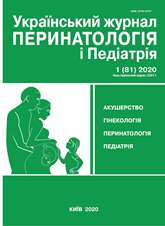Phytocomplex in combination with standard treatment for the correction of metabolic disorders and pregravar training in women with endocrine infertility
DOI:
https://doi.org/10.15574/PP.2020.81.38Keywords:
metabolic syndrome, PCOS, endocrine infertility in history, Domenorm maxi, MetforminAbstract
High rates of metabolic disorders in women with endocrine infertility are due to the presence of such risk factors as: age over 30 years, metabolic syndrome, obesity, insulin resistance.Purpose — to determine the depth of metabolic disorders and to improve the complex of pregravity training for women with endocrine infertility.
Patients and methods. We examined 102 patients with endocrine infertility who were assigned various courses of pregravity training for 3 months. The selection of patients included women with polycystic ovary syndrome (PCOS) who had metabolic syndrome. Patients were divided into groups, depending on the prescribed treatment regimen: І — the group of 35 women with endocrine infertility, who were assigned Domenorm maxi in combination with diet as pregravity training; ІІ — the group of 37 patients with endocrine infertility, who for the purpose of pregravidar training received Metformin in combination with diet; ІІІ — the group of 30 patients with endocrine infertility, which as pregravidar training was assigned a complex of Domenorm maxi, Metformin in combination with diet. All women before and after treatment were measured blood pressure (BP) and waist circumference (WC); blood glucose levels and the HOMA index, as well as triglycerides (TG) and high-density lipoproteids (HDL).
Results. The best results in the normalization of metabolic disorders, namely: the decrease in blood pressure was in 83.3%, normalization of blood glucose levels — in 90%, HOMA index returned to normal — in 93.3%, HDL and TG decreased in 90%, WC decreased 73.3% of women in the third group with endocrine infertility who took the scheme were in the Domenorm maxi, Metformin and diet. Somewhat differed in effectiveness depending on the effect on a particular link pathogenesis of metabolic syndrome, the schemes that took the І and the ІІ group. But both schemes have shown their effectiveness. Scheme: the Domenorm maxi and diet, which were taken by the patients of the group was quite effective. Thus, the blood pressure of these women decreased in 71.4% of patients, blood glucose — in 57.1%, the HOMA index — in 62.9%, HDL — in 71.4%, TG — in 74.3%, waist circumference decreased by 28.6%. Treatment with Metformin and diet showed a weak effect in lowering blood pressure, only 18.7% of patients, but their waist circumference decreased in almost half — in 48.6% of women II group. HDL decreased in 73.3% and TG in 78.4% of patients, and blood glucose decreased in 81% and the HOMA index in 78.4% of patients in the second group.
Conclusions. The depth of metabolic disorders in women with PCOS and the possibility of their correction taking into account the need for a multifactorial approach to complex therapy of pregravity training has been investigated.
The research was carried out in accordance with the principles of the Helsinki Declaration. The study protocol was approved by the Local Ethics Committee of this Institute. The informed consent of the patient was obtained for conducting the studies.
No conflict of interest were declared by the author.
References
Pyrohova VI. (2019). Suchasni trendy v likuvanni syndromu polikistoznykh yaiechnykiv. Zdorov'ia Ukrainy. 2 (34): 28–29.
Tatarchuk TF, Tutchenko TM, Perekhrestenko OV, Kalashnykov OO, Hlamazda MI. (2018). Metabolichnyi syndrom: shcho zminylos za 30 rokiv. Almanakh reproduktyvnoho zdorov'ia: 53–69.
Tronko MD, Antypkin YuH, Kaminskyi VV, Tatarchuk TF. (2016). Natsionalnyi konsensus shchodo vedennia patsiientok iz hiperandroheniieiu. Reproduktyvna endokrynolohiia. 4 (30): 3–15
Antuna-Puente B et al. (2011, Jun). How can we measure insulin sensitivity/resistance? Diabetes Metab. 37 (3): 179–188. https://doi.org/10.1016/j.diabet.2011.01.002; PMid:21435930. Epub 2011 Mar 23.
Gayoso-Diz P et al. (2013, Oct 16). Insulin resistance (HOMA-IR) cut-off values and the metabolic syndrome in a general adult population: effect of gender and age: EPIRCE cross-sectional study. BMC Endocr Disord. 13: 47. https://doi.org/10.1186/1472-6823-13-47; PMid:24131857 PMCid:PMC4016563.
Lann D et al. (2007, Nov). Insulin resistance as the underlying cause for the metabolic syndrome. Med Clin North Am. 91 (6): 1063–1077. https://doi.org/10.1016/j.mcna.2007.06.012; PMid:17964909
Moghetti P et al. (2016, Deс). Insulin Resistance and Polycystic Ovary Syndrome. Curr Pharm. 22 (36): 5526–5534. https://doi.org/10.2174/1381612822666160720155855; PMid:27510482
Polac K et al. (2017). New markers of insulin resistance and polycystic ovary syndrome. J Endocrinol Invest. 40: 447–454.
Downloads
Issue
Section
License
The policy of the Journal “Ukrainian Journal of Perinatology and Pediatrics” is compatible with the vast majority of funders' of open access and self-archiving policies. The journal provides immediate open access route being convinced that everyone – not only scientists - can benefit from research results, and publishes articles exclusively under open access distribution, with a Creative Commons Attribution-Noncommercial 4.0 international license(СС BY-NC).
Authors transfer the copyright to the Journal “MODERN PEDIATRICS. UKRAINE” when the manuscript is accepted for publication. Authors declare that this manuscript has not been published nor is under simultaneous consideration for publication elsewhere. After publication, the articles become freely available on-line to the public.
Readers have the right to use, distribute, and reproduce articles in any medium, provided the articles and the journal are properly cited.
The use of published materials for commercial purposes is strongly prohibited.

